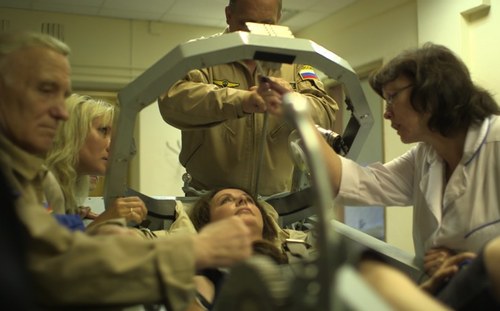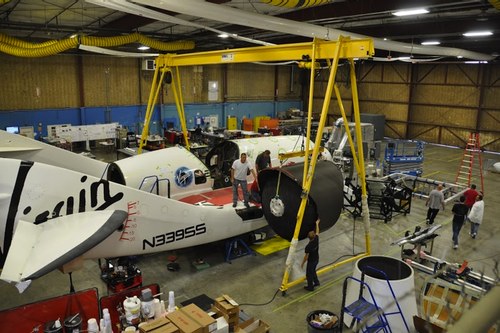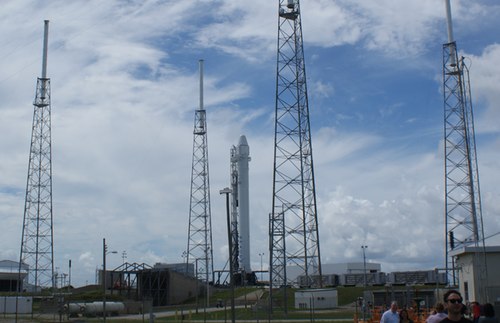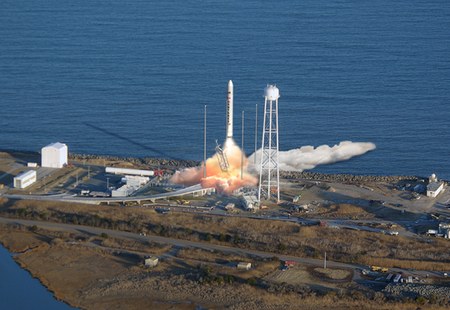|
|
In the latest round of awards in NASA’s commercial crew program, Boeing won the largest amount of money, $460 million, versus SpaceX’s $440 million and Sierra Nevada’s $212 million. NASA officials noted at the time that the dollar values in the awards were not intended to be a ranking of the companies, but it was clear that Boeing and SpaceX were the frontrunners. However, it’s Boeing that may be worried it’s falling behind.
In Sunday’s Florida Today, former NASA astronaut Chris Ferguson, who is now the head of crew and mission operations for Boeing’s commercial crew effort, said the company is thinking about increasing its own investment to keep up with SpaceX. Boeing’s CST-100 is currently scheduled to make its first crewed test flight in late 2016, while SpaceX is planning a mid-2015 crewed test flight of its Dragon spacecraft. “We’re looking heavily into getting some additional Boeing investment to move that (late 2016) date to the left significantly, which we think we need to do to keep pace with SpaceX,” Ferguson told Florida Today.
Any additional investment would address one key weakness in Boeing’s proposal for the Commercial Crew Integrated Capability (CCiCap) award it won. The selection statement from NASA noted that Boeing’s “proposed corporate investment during the CCiCap period does not provide significant industry financial investment and there is increased risk of having insufficient funding in the base period.” The amount of Boeing’s proposed investment was redacted in the Space Act Agreement document released by NASA.
 Sarah Brightman attended to during tests that confirmed her fitness to fly to space as a space tourist in 2015. Some Russian officials have raised doubts that she will fly. (credit: sarahbrightman.com) Last month, with considerable fanfare, Space Adventures and the Russian space agency Roscosmos announced at a press conference in Moscow that singer Sarah Brightman would be the next commercial spaceflight participant (aka space tourist) to visit the International Space Station (ISS). The announcement contained few details about her trip, including when she would go, although speculation centered around 2015, when NASA and Roscosmos will have ISS crewmembers on a first-of-its-kind year-long stay on the ISS, freeing up seats on Soyuz flights to and from the ISS. Brightman and Space Adventures have said little about the future flight since the press conference.
This week, Russian space industry officials have raised questions about how serious Brightman is about flying in space. Interfax reported earlier this week that unnamed officials have speculated Brightman’s announcement last month was designed to generate publicity for her upcoming album and world tour, which did come up during the press conference. “It is very probable that the singer said she may fly to the ISS to fuel interest in her year-long world tour, which she will begin next year,” the unnamed source told Interfax.
Sergei Krikalev, the former cosmonaut who now heads Russia’s cosmonaut training center, said those claims were news to him, but added he wasn’t surprised. “Many years ago there was an option to send one singer into space. He had undergone a medical selection and there were plans to sign a contract with him,” he said, referring to Lance Bass, who ten years ago had plans to fly as a space tourist but failed to line up sponsorship deals to pay for the flight.
The head of Roscosmos, Vladimir Popovkin, spoke up on Friday in response to those reports, saying that Brightman was still planning to fly, but that Roscosmos hasn’t made a formal decision yet. “I have met her, she is all set to fly, but Roscosmos has not yet decided on it,” he told RIA Novosti, adding that Roscosmos would make a decision in the first half of 2013. (Interfax said the decision wouldn’t come until the second half of 2013.)
The claims by Russian officials that Brightman wouldn’t fly may be evidence of more general disdain about flying space tourists on Soyuz flights. “Space tourism is, unfortunately, a major problem for professionals like us,” said Pavel Vinogradov, another former cosmonaut who is now deputy head of the Energia Flight Space Center. “Tourism undermines the very foundation of manned space flights, because we have to replace young cosmonauts with tourists.”
Popovkin made a similar comment to Interfax when asked why Roscosmos hasn’t made a decision yet about Brightman: “We need to provide young cosmonauts with flight practice.” The decision may hinge on whether the additional revenue such a flight would provide Roscosmos—on the order of $50 million—overcomes their reticence of flying tourists versus professional cosmonauts.
XCOR Aerospace announced yesterday that it has issued a contract to ATK for the manufacturing of the wings and control surfaces of XCOR’s Lynx Mark 1 suborbital spaceplane. ATK is best known (in the space industry, at least) for its solid propellant motors, including the Solid Rocket Boosters (SRBs) used to launch the Space Shuttle. A five-segment version of those SRBs will be used initially for the Space Launch System (SLS). ATK had also planned to use those five-segment motors as the first stage of its Liberty launch vehicle, but those plans are in limbo after ATK didn’t win an award in the latest round of NASA’s Commercial Crew Program.
ATK, though, is also known for its work on aerospace composite structures, and XCOR management had no problem working with them for the Lynx wings. “With this effort we are establishing a model of how smaller NewSpace companies may utilize established government primes as our suppliers,” said XCOR COO Andrew Nelson in the statement announcing the contract. “ATK has demonstrated they are nimble, cost effective and can leverage deep experience from prior larger projects.”
XCOR has been in the news for something else it isn’t doing: point-to-point transportation. XCOR officials reportedly told The Huffington Post that the company was planning to fly vehicles to go from New York to Tokyo in 90 minutes, albeit only within the next 20 years. (That report appeared to be based in part on a piece in September by Gadling, which in turn appears to be based on an article by Business Insider.)
There’s just one problem: XCOR isn’t planning on doing point-to-point passenger flight any time in the foreseeable future. Jim Muncy, representing XCOR at the SpaceVision 2012 conference in Buffalo, New York, last week, said it didn’t appear to be as profitable a market as orbital activities. “XCOR has no plans whatsoever to do point-to-point transportation,” he said. The energy requirements of such flights are roughly the same as doing orbital flights, he explained, which are more lucrative than passenger flights. “You make a lot more money flying to orbit than you do flying from Europe to Shanghai. We would prefer to be in the profitable industry of flying people to orbit.”
Those who have closely followed NASA’s Commercial Crew Program may have noticed something a little unusual about the latest phase of the effort. Previous phases of the program were known as Commercial Crew Development, or CCDev, but this latest phase is called the Commercial Crew Integrated Capability. It’s known not as CCIC, or CCICap, but instead CCiCap, with a lowercase “i”. What’s up with that?
Speaking at the SpaceVision 2012 conference in Buffalo, New York, on Saturday, Ed Mango, manager of NASA’s Commercial Crew Program, offered an explanation: it’s an homage of sorts to a company outside the space industry. “I purposely put the little ‘i’ in there—I get to do that, as a program manager—because most of us have iPhones, and a lot of us might have iPads,” he said, referring to two of the most popular products made by Apple. Those products, he said, revolutionized communications. “They transformed the way we do information sharing. So, in my mind, what we’re doing today is an integrated capability and we’re trying to change the way the world, the way the United States, is going to focus on low Earth orbit.”
This is not the first time that NASA has exercised a little creativity in choosing the names and acronyms for its commercial vehicle development efforts. After NASA started the Commercial Orbital Transportation Services (COTS) effort, it established an office to manage it. The logical name for it was the Commercial Crew and Cargo Program (since COTS originally included options for crewed vehicle development). The problem: the acronym for this was CCCP, which in the Cyrillic alphabet is the acronym for the USSR. NASA’s clever solution was to append “Office” to the name, thus becoming CCCPO or, by condensing the C’s, C3PO. Evidently Lucasfilm never complained…
 An image from Virgin Galactic of the liquid oxidizer tank being installed in SpaceShipTwo. (credit: Virgin Galactic) The two companies in the lead to fly crewed suborbital spacecraft announced milestones earlier this week towards the beginning of powered flight tests of their vehicles. On Friday, Virgin Galactic released images of an oxidizer tank being installed in SpaceShipTwo. The tank is a major element of the spacecraft’s hybrid propulsion system, which uses nitrous oxide as a liquid oxidizer along with a solid fuel.
The tank installation also inspired a blog post on the corporate Virgin website by Sir Richard Branson. In it, he drops a hint that the current hybrid propulsion system, which Virgin has billed as being environmentally friendly, might be replaced by something even more benign. “We’re now looking at some exciting future plans which could radically lower each flight’s remaining environmental footprint. More on that in due course!”
As for when that first powered test flight might take place, Virgin Galactic has, as it has done so for years, emphasized they’re focused on safety rather than making schedule. Even Branson didn’t offer much in his post. “[W]e’re leaving no stone unturned as we approach the first supersonic, rocket-powered flights of SpaceShipTwo,” he writes. “Our amazing engineers and pilots are preparing right now for the first powered spaceship flight, which should be followed with a fairly quick build up to Virgin’s first proper step across the final frontier!”
In a talk last month at the AIAA Space 2012 conference in Pasadena, California, Steve Isakowitz, executive vice president and chief technology officer of Virgin Galactic, said the company had set an “aggressive” goal of an initial powered flight by the end of the year. That, however, he added that schedule would be paced on how things were coming together.
As Virgin gets SpaceShipTwo ready at one area of Mojave Air and Space Port in California, in another area XCOR Aerospace is getting making progress on its Lynx Mark 1 prototype spaceplane. At the International Symposium for Personal and Commercial Spaceflight (ISPCS) in Las Cruces, New Mexico, on Thursday, XCOR COO Andrew Nelson announced that the company had completed another major test just Wednesday: firing the liquid oxygen and kerosene engines while mounted in a “flight-weight fuselage” with “real” pumps. The engines were “spewing out fire at our test site in Mojave,” he said. “It was an exciting day for XCOR.” Video of the engine test, he said, should be released in the next week.
XCOR had previously indicated they planned to start low-level (“air under the gear”) flight tests, part of a larger series of incremental tests of the Lynx, by late this year. Those flights appear to have slipped into early next year, based on Nelson’s comments at ISPCS. “We are progressing quickly on building and fielding the Lynx and flying it in the new year,” he said.
 Falcon 9 and the CRS-1 Dragon spacecraft on the launch pad at Cape Canaveral about seven and a half hours before its scheduled launch Sunday. (credit: J. Foust) SpaceX is less than five hours from launching the first of twelve cargo missions to the ISS—technology and weather permitting. SpaceX erected the Falcon 9 rocket, with its Dragon spacecraft on top, shortly before 1 pm Eastern time this afternoon. The rocket is slated to launch at 8:35 pm EDT tonight (0035 GMT Monday) in an instantaneous launch window, which means that any technical glitch or weather problem would scrub the launch for the night. There are no technical issues being reported, and forecasts call for a 60% chance of acceptable weather at launch time.
This mission is designated by NASA as CRS-1: the first Commercial Resupply Services flight by SpaceX to the International Space Station. The Dragon is carrying a relatively light load when measured by mass: about 400 kilograms of equipment and other supplies. NASA and SpaceX officials, though, said the volume of the Dragon is filled with experiments and other equipment for the station. Dragon will also bring back 760 kilograms of equipment from the station, including blood and urine samples collected during experiments on the station over more than a year. While the pverall mass is low, SpaceX president Gwynne Shotwell said at a press conference yesterday that they anticipate, over all 12 CRS flights, to transport 60 metric tons of cargo to and from the station (their contract with NASA calls for at least 20 metric tons to the station.)
Getting these flights started will be a milestone for commercial spaceflight, demonstrating its ability to do something that previously was done by space agencies only, and thus freeing up NASA to do cutting-edge exploration beyond LEO. It’s also important, though, the the utilization of the ISS itself: the long-term future of the ISS depends on the quantity and quality of the research being performed there, which requires regular access to transport experiments and other suppliers both to and from the station. Julie Robinson, the NASA ISS program scientist, said yesterday there are over 100 experiments active on the US segment of the ISS at any one time. The station, she said, is now a “dynamic and fully-established lab” and “it’s really full-bore, full speed ahead.”
Author J.K. Rowling, best known for the Harry Potter series of bestselling books, is back in the headlines with the release of her first post-Potter novel, The Causal Vacancy. In the publicity surrounding the release of the book, Rowling has made some space-related headlines by suggesting she created a cosmic vacancy, if you will, by turning down a curious spaceflight offer.
The UK news agency Press Association reported that Rowling, speaking in London on Thursday, claimed she had been offered a flight into space, apparently on the Space Shuttle. “I was offered a seat. For a mere £2 million [US$3.2 million] I could have been on the shuttle, but I turned it down,” she said, according to the report. The article doesn’t state if Rowling mentioned when she was offered the seat, or why she turned it down.
There are problems with this report, though. First of all, seats on Space Shuttle flights were controlled by NASA, which did not offer them for sale at any price. (And, even if they did, Rowling would be an odd choice to be offered a seat.) Second, the price seems out line of what is being offered for commercial human spaceflights, assuming she confused another vehicle with the shuttle. Soyuz flights, for example, cost about an order of magnitude more than that: upwards of $40 million today, according to various reports. Suborbital flights, like that offered by Virgin Galactic, cost far less: $200,000 or less. Perhaps Hermione can conjure a spell to reveal the truth about this claim…
Space tourism company Space Adventures sent out a media advisory Wednesday morning about a press conference the company plans to hold in Moscow on October 10. “Sarah Brightman will be in Moscow to make a ‘groundbreaking’ announcement,” the advisory states, without offering details about that announcement. Brightman, an “international singing superstar” in the words of the media advisory, will be joined at the event by a Russian TV personality, Mikhail Gendelev, as well as Space Adventures chairman Eric Anderson.
The announcement would seem to confirm some media reports last month that Brightman was interested in flying to the International Space Station as a space tourist, although we won’t know for certain until next month’s press conference. One issue will be the timing of the trip: for the time being there are no extra seats available on Soyuz spacecraft going to and from the ISS, as they are currently used exclusively for rotating ISS crewmembers. Space Adventures has talked in the past about a dedicated Soyuz flight, with one professional cosmonaut pilot and two commercial passengers. Another possibility is that one or more ISS crewmembers may stay on the station for up to a year to study the effects of an extended mission, like one to Mars; that would free up seats on the Soyuz vehicles (which have a six-month orbital lifetime) for commercial passengers like Brightman.
Venture capitalist Steve Jurvetson, an investor in SpaceX, was recently at the company’s Texas test facility and got a look at Grasshopper (above), SpaceX’s reusable launch vehicle technology demonstrator. About a year ago SpaceX revealed its plans to develop a reusable version of the Falcon 9 rocket, including a first stage that would fly back to the launch pad. Grasshopper is the company’s first major step in demonstrating that ability to fly back and land vertically.
At the AIAA Space 2012 conference in Pasadena, California, on Tuesday, SpaceX’s Brian Bjelde said that Grasshopper will fly for the first time in the near future, having already completed a static test. “As of last week, we did a static fire of the engine on the Grasshopper,” he said. “Very soon we’re going to be a couple of little mini hops. Then we’ll do hops up to 1,000 feet, some hovers, maybe even higher.” The higher flights are pending approval of the FAA, which has given clearance for the initial, lower-altitude tests, he said.
 Illustration of Orbital’s Antares rocket lifting off from the Mid-Altantic Regional Spaceport (MARS) in Virginia. (Credit: OSC) In July, Orbital Sciences Corporation announced a new schedule for the initial tests of its Antares rocket, including the first launches of the vehicle that will be used to send the Cygnus cargo spacecraft to the ISS. At that time Orbital planned a hot-fire test on the pad at Virginia’s Mid-Atlantic Regional Spaceport (MARS) in late August or early September, followed by an inaugural demonstration launch in October and the first Cygnus launch in December. It’s mid-September now, though, and that hot-fire test hasn’t taken place. What’s up?
Orbital officials at the AIAA Space 2012 conference in Pasadena, California, this week, said they’re still awaiting formal turnover of the pad at MARS from the state of Virginia, which is building it. “It’s our anticipation that that launch pad will be certified and turned over to us in the very near future,” said Orbital’s Mark Pieczynski. That handover, Orbital officials said, should happen this month and could take place almost any day now. The delays have involved getting final certification from NASA of the pad’s systems. “The launch site is complete. It’s going through what we would call a ‘closing-out punch list,'” he said. “We’re simply at this point waiting for the state of Virginia to hand us the keys.”
Once Orbital finally has access to the pad, they plan to move quickly with a series of tests. As soon as a day after the handover, Orbital will roll out a test Antares vehicles to the pad, including a wet dress rehearsal. About two weeks after the rehearsal, Orbital will perform the hot-fire test. After a review of the data from the static test, Orbital will roll out the first flight vehicle to the pad, with a launch anticipated about a month after the static test. That would put that launch probably in the early November timeframe, depending on how soon they get access to the pad.
|
|






Recent Comments